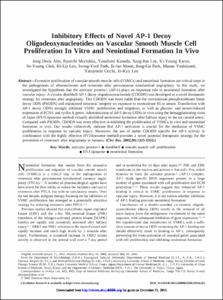KUMEL Repository
1. Journal Papers (연구논문)
1. School of Medicine (의과대학)
Dept. of Thoracic & Cardiovascular Surgery (흉부외과학)
Inhibitory Effects of Novel AP-1 Decoy Oligodeoxynucleotides on Vascular Smooth Muscle Cell Proliferation In Vitro and Neointimal Formation In Vivo
- Keimyung Author(s)
- Choi, Sae Young; Kwon, Ki Young; Lee, In Kyu; Park, Jong Gu
- Department
- Dept. of Thoracic & Cardiovascular Surgery (흉부외과학)
Dept. of Internal Medicine (내과학)
Dept. of Molecular Medicine (분자의학)
- Journal Title
- Circulation Research
- Issued Date
- 2002
- Volume
- 90
- Issue
- 12
- Abstract
- —Excessive proliferation of vascular smooth muscle cells (VSMCs) and neointimal formation are critical steps in
the pathogenesis of atherosclerosis and restenosis after percutaneous transluminal angioplasty. In this study, we
investigated the hypothesis that the activator protein-1 (AP-1) plays an important role in neointimal formation after
vascular injury. A circular dumbbell AP-1 decoy oligodeoxynucleotide (CDODN) was developed as a novel therapeutic
strategy for restenosis after angioplasty. This CDODN was more stable than the conventional phosphorothioate linear
decoy ODN (PSODN) and maintained structural integrity on exposure to exonuclease III or serum. Transfection with
AP-1 decoy ODNs strongly inhibited VSMC proliferation and migration, as well as glucose- and serum-induced
expression of PCNA and cyclin A genes. Administration of AP-1 decoy ODNs in vivo using the hemagglutinating virus
of Japan (HVJ)-liposome method virtually abolished neointimal formation after balloon injury to the rat carotid artery.
Compared with PSODN, CDODN was more effective in inhibiting the proliferation of VSMCs in vitro and neointimal
formation in vivo. Our results collectively indicate that AP-1 activation is crucial for the mediation of VSMC
proliferation in response to vascular injury. Moreover, the use of stable CDODN specific for AP-1 activity in
combination with the highly effective HVJ-liposome method provides a novel potential therapeutic strategy for the
prevention of restenosis after angioplasty in humans. (Circ Res. 2002;90:1325-1332.)
Key Words: activator protein-1 dumbbell smooth muscle cell proliferation
HVJ-liposome neointimal formation
- Publisher
- School of Medicine
- Citation
- Jong Deok Ahn et al. (2002). Inhibitory Effects of Novel AP-1 Decoy
Oligodeoxynucleotides on Vascular Smooth Muscle Cell
Proliferation In Vitro and Neointimal Formation In Vivo. Circulation Research, 90(12), 1325–1332. doi: 10.1161/01.RES.0000023200.19316.D5
- Type
- Article
- ISSN
- 0009-7330
- 파일 목록
-
-
Download
 oak-aaa-01397.pdf
기타 데이터 / 611.39 kB / Adobe PDF
oak-aaa-01397.pdf
기타 데이터 / 611.39 kB / Adobe PDF
-
Items in Repository are protected by copyright, with all rights reserved, unless otherwise indicated.